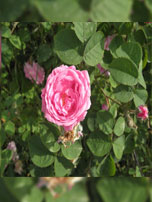SHAHEED KARTAR SINGH SARABHA AYURVEDIC MEDICAL COLLEGE & HOSPITAL
Affiliated to Guru Ravidas Ayurved University, Hoshiarpur Punjab
Affiliated to Guru Ravidas Ayurved University, Hoshiarpur Punjab

Botanical Name : Rosa centifolia Linn.
Family : Rosaceae
Introduction :
Latin name : Rosa = Latin name, a root word for colour in many languages; centifolia = hundred petals
Scientific classification: Roses make up the family Rosaceae of the order Rosales. The representative genus is Rosa. Hybrid perpetuals, or remontant roses, are derived mainly from the hybrid species Rosa borboniana; polyantha roses from the hybrid species Rosa rehderana;tea roses from Rosa odorata; and China roses from Rosa odorata andRosa chinensis.
There were a believe, Prior to the world war scientists artificially created a ‘black rose’, some people said that would be a misfortune.
Names in different Indian languages :
English : Cabbage Rose, Provence Rose, Hundred-leaved Rose
Hindi : Gulab
Kannada : Gulabi,
Malayalam : Paninir, rosappu
Sanskrit : Taruni
Tamil : Iroja, Rajapoo, eros
Telugu : Gulabi, Rajapoo
Unani : Gul-e-Surkh
Synonyms :
Shatapatri, Shatapatrika, Taruni, Devataruni, Karnikaa, Chaarukesharaa, Laakshaa, Gandhaaddhyaa.
Varieties & adulterants – (CV – controversy, AD – adulterants) :
Out of the innumerable varieties of rose, twelve are of Indian origin. Others are of foreign origin. They are classified on the basis of their fragrance, urban or wild origin and many other factors.
Rose, common name for a medium-size family of flowering plants with many important fruit and ornamental species, and for its representative genus. Worldwide in distribution, the rose family contains about 107 genera and 3100 species.
The rose family is placed in an order with 24 other families. This order is sometimes referred to as the rose order. Other important members of the order include the saxifrage family and the stonecrop family. Another family, the coco-plum family, occurs in the lowland Tropics and contains about 400 species, several of which are used locally for their timber, oilseeds, and fruits. Perhaps the best-known member of the family is the coco plum, found in southern Florida on sandy beaches and swamps; its sweet fruits are made into jelly or preserves.
Plants of the rose order may vary greatly in habit, from trees to shrubs or often perennial herbs. The leaves usually have stipules (leaflike appendages at the base of the leafstalk) and are often compound. The flowers usually have five sepals (outer floral whorl) and five petals (inner floral whorl) and numerous stamens (male floral organs). The female portion of the flower consists of from one to many pistils, which are free from one another or are variously fused. The ovary or ovaries (egg-producing portion of the pistil) are hypogynous or, more often, perigynous (half-inferior), with the sepals, petals, and stamen borne on the rim of a tubular structure surrounding the ovary base
Morphology :
Many varieties have emerged out of hybridization. The shrub is 25 cm. to 3 mt. in height, branches bear
thorns. Leaves – have serrated margins.
Flowers have many shades of colours.
Fruit – oval and becomes red on ripening.
Distribution & Habitat :
Garden plant
Chemical constituents :
saponin , methionine sulphoxide,citronellol, geraniol, nerol, phenylethanol, linalool,citral.
Properties :
Guna : laghu, singdha;
Rasa : tikta, katu, kashaya. madhur;
Vipaka : madhur,
Virya : sheeta
Karma :
Ruchya, mukhsopha hara, varnya, cashkuksya
Cardio tonic, carminative, digestive, astingent,cooling, diuretic
Indication :
Daham, peenasa, swasa, kasa
Ulcers, wounds, fever, skin disease, cough, piles, leucorrhoea, mouth ulcers
Part used :
Whole plant
Dosage :
Leaf juice 10-15 ml
Powder 2-4 g
Decoction 50-100 ml
External uses :
It improves complexion and acts as wound healing, deodorant and anti inflammatory. It is therefore useful in disorders of complexion and inflammatory diseases. It removes foul smell of sweat.
Internal Uses :
It acts as a brain tonic as well as increases the tone of the gastrointestinal tract. It is a hepatoprotective and is useful in all digestive disorders like diarrhoea and dysentery. It is useful in diseases of the heart, bleeding disorders and other blood diseases, It is useful in fever and burning sensation. Rose buds increase the bulk of solid excrete It is also useful in impotency
